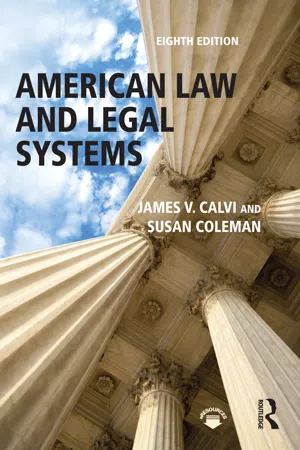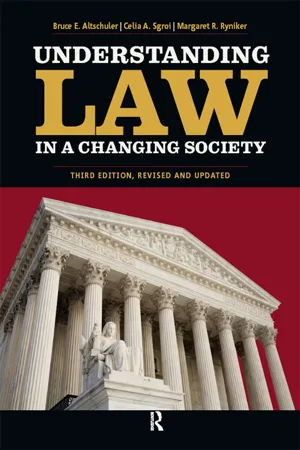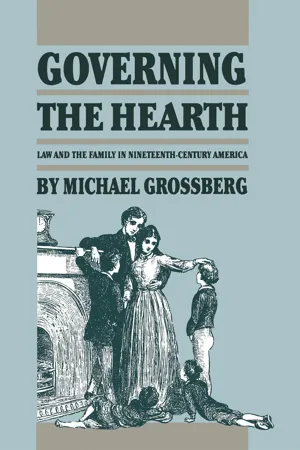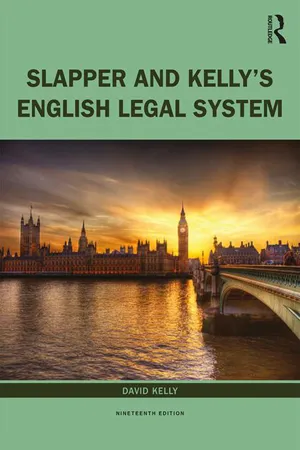Law
Family Law
Family law encompasses legal matters related to family relationships and domestic issues. This area of law covers a wide range of topics, including marriage, divorce, child custody, adoption, and domestic violence. Family law aims to protect the rights and well-being of individuals within the family unit and provides a framework for resolving disputes and establishing legal relationships within families.
Written by Perlego with AI-assistance
7 Key excerpts on "Family Law"
- eBook - ePub
- Jill Elaine Hasday(Author)
- 2014(Publication Date)
- Harvard University Press(Publisher)
INTRODUCTION The Family Law CanonThe law shapes all of our lives, even when we do not realize it is there. It decides who has rights to what, who can make enforceable claims on whom, who is entitled and who is not. Family life is sometimes presumed to be a realm so private and intimate as to be beyond the law’s power. Indeed, the United States Supreme Court itself has contributed to that notion, repeatedly declaring that there is a “private realm of family life which the state cannot enter.”1But in fact, one of the law’s most important and far-reaching roles is to govern family life and family members. Family Law regulates the creation and dissolution of legally recognized family relationships and establishes the legal rights and responsibilities that are tied to family status. This means that Family Law decides who counts as kin in the eyes of the law and who does not, how family relationships are legally formed and severed, and what turns on legal recognition as a family member—what it means legally to be a spouse, parent, child, sibling, or other relative as one interacts with the government and with other people inside and outside of one’s family.Family Law is extraordinarily consequential, whether measured in terms of impact on people’s lives, volume of litigation, or monetary, psychological, and cultural goods at stake. Family Law shapes social organization, economic status, intergenerational relationships, intimacy, childhood, maturity, and everyday experience. It reflects and influences how Americans think about gender, race, class, sexual orientation, and other divides and helps determine how those categories will impact people’s opportunities, choices, rights, and constraints. Family Law helps structure both the details of daily existence and the overarching features of society.Family Law pervades state and federal law, in part because many sources of law that are now identified exclusively with other legal fields are also forms of Family Law. Family Law extends far beyond statutes, judicial opinions, and regulations that are explicitly and officially classified as Family Law to run through tort law, contract law, property law, constitutional law, criminal law, tax law, employment law, labor law, immigration law, citizenship law, international relations law, military law, welfare law, social benefits law, public health law, education law, housing law, bankruptcy law, intellectual property law, agricultural law, Native American law, evidence law, personal jurisdiction law, and more. - eBook - ePub
- David L Hudson(Author)
- 2010(Publication Date)
- Visible Ink Press(Publisher)
What types of issues are covered by Family Law, or the law of domestic relations?
This area encompasses all aspects of intra-familial life, including but not limited to marriage, divorce, child custody, child support, child visitation, adoption, paternity, and surrogacy. Most state law codes contain a separate section or sections—called a title or titles—that deal exclusively with Family Law. For example, there is a separate title (Title 25) in Arizona called “Marital and Domestic Relations.” Tennessee has a separate title (Title 36) called “Domestic Relations.” Often attorneys will specialize in particular aspects of Family Law given the complexity and depth of the subject.Family Law interacts with many other areas of law, including contracts, torts, crimes, and other areas. Marriage itself is a civil contract between two parties (in nearly every state between one man and one woman). Both parties must consent to the marriage just as with any other type of contract. Sometimes parties will enter into contractual arrangements before marriage referred to as prenuptial agreements. Sometimes parties to a marriage will allege criminal and/or tortious (wrongful) conduct committed by their partner.MARRIAGE
How is marriage defined by the law?
Marriage is a civil contract or union between two persons (in nearly all U.S. jurisdictions between one man and one woman) who live together and share their lives together (at least until a dissolution). Ideally, the two people share deep emotional and physical bonds that allow them to survive and even thrive during the hardships of life. Unfortunately, we know that a large number of marriages dissolve and end up in divorce.How can people be married?
Most people are married through a ceremony performed by a religious figure or a secular figure authorized by the state to perform marriages. Many people are married in churches or chapels by a minister of one of the person’s church. Others are married at the local courthouse by a judge or justice of the peace. Still others are married by a family friend who has the authority as a lay person to perform marriages. These unions are referred to as ceremonial marriages, because the institution or process of marriage is performed through a ceremony. - eBook - ePub
- James V. Calvi, Susan Coleman(Authors)
- 2016(Publication Date)
- Routledge(Publisher)
CHAPTER 13 Family LawFamilies in this country generate a great deal of litigation. Few lawsuits match the magnitude of the impact on the individuals involved, with the exception of the most serious felony cases. These suits impinge upon the most sensitive and personal of relationships; these are the cases that dissolve marriages and determine the custody of children. Many are decided without blazing courtroom battles (the arguments have usually occurred earlier, behind closed doors). Many Family Law cases are settled by agreement between the parties, and the courtroom proceedings may seem routine and bland to the detached observer, but the emotional impact on the parties is immeasurable.Laws that affect familial relationships span many fields, including property law, wills and estates, contracts, torts, and criminal law. This chapter focuses on the creation of the family relationship by marriage or other types of domestic commitments, by paternity suits, and by adoption; on the legal principles governing such relations; and on the dissolution of the spousal and parent–child relationship through various types of court action. State legislatures and courts bear the primary onus of dealing with the sometimes complex, often time-consuming issues of Family Law. It is rare for the U.S. Supreme Court to consider a case involving these matters, although a few involving constitutional questions, such as equal protection, have reached the Court. It is state courts––often specially created domestic-relation courts––that try and then decide the overwhelming majority of such cases.ROLE OF THE STATE IN FAMILY RELATIONSHIPS
The role of the state in regulating family relationships is so firmly entrenched in jurisprudence that it is virtually unchallenged by today’s litigants. In Rome by the time of Christianity, marriage required only the reciprocal consent of the couple, a precursor of today’s informal marriages. During this time, the parties were essentially equal; the husband controlled neither the wife nor her property, although he was obligated to maintain her financially, and either party could end the marriage.1 - eBook - ePub
- Bruce E. Altschuler, Celia A. Sgroi, Margaret R. Ryniker(Authors)
- 2016(Publication Date)
- Routledge(Publisher)
HAPTER 9Family Law CHAPTER OBJECTIVES After reading this chapter you should: • comprehend the nature of the family and the changing role of women in the family; • understand the legal definition of marriage and how it has changed; • grasp the Best Interests of the Child Standard used in child custody cases; • comprehend the limited legal standing of unwed fathers; • know the definition of surrogacy and the pitfalls of surrogacy arrangements; and • understand the problems that arise in parental termination cases. INTRODUCTION Family Law includes laws governing marriage, divorce, child custody, child support, adoption, surrogacy, and termination of parental rights. These laws have evolved piecemeal in every state.Historically, the federal government has sought to avoid family matters, in the belief that such issues should be handled locally by the states. Questions of Family Law were deemed to be of such a personal nature that each jurisdiction needed to determine its own laws guided by its own state’s moral compass. Over the last forty years, however, the federal government has addressed a number of Family Law issues, from unwed fathers’ rights to welfare reform.At the outset, we must consider the definition of the term family. When we think of a family, we may imagine the married, heterosexual couple with two children. Such families do exist, but they are the minority. In reality, we have all kinds of families, including single-parent families, blended families (second marriages with children from previous unions), families with grandparents raising grandchildren, and gay and heterosexual couples with and without children. In 1989 the New York Court of Appeals recognized a gay partnership as a family so as to allow the surviving partner to maintain possession of a rent-controlled apartment in New York City. See Braschi v. Stahl Associates Co., 74 N.Y.2d 201, 543 N.E.2d 49, 544 N.Y.S. 2d 784, 58 USLW 2049 (1989.) Family - eBook - ePub
Studies in Legal History
Law and the Family in Nineteenth-Century America
- Michael Grossberg(Author)
- 2004(Publication Date)
- The University of North Carolina Press(Publisher)
Definitions of domestic relations like Schouler’s document some cardinal assumptions of Family Law that emerged in the nineteenth century. Each family member had distinct legal interests and rights drawn from his or her individuality, and the judiciary had the primary duty of resolving conflicts between them. This concept of the family, and the broad judicial powers it encouraged, upset traditional Family Law. In the past the family had been perceived to be a community of interests governed by a publicly accountable patriarch. The displacement of that concept fostered a legal climate dominated by clashes over the proper allocation of private and public domestic authority.As a result, in nineteenth-century America, Family Law became the chief instrument of the republican state for determining the legal responsibilities of family members. In a society that placed great reliance on the law for settling conflicts, fixing status, and protecting wealth and authority, domestic-relations law helped establish the boundaries within which families formed and lived. It did so by occupying a position on the border between the public and private spheres of American society. Slowly it became the most personal aspect of public law, the most public aspect of private law.Yet the law dealt with selected elements of domestic life. Most families did not become entangled in the legal system; generally, only couples or households riven by death or disputes resorted to the law. Antebellum Ohio legal writer Edward Mansfield’s observation on marriage law can be applied to the entire corpus of domestic relations; he reminded the readers of his 1845 book on women’s legal rights that the nuptial code was “too narrow in jurisdiction and too imperfect in its knowledge, to determine, regulate, or constrain those internal affections upon which, at last, the whole harmony and efficacy of the marriage relation depends. Too many expect from law more than law can give.”60But those rising expectations produced a dynamic law of the family that played a prominent role in defining and enforcing household roles, duties, and rights. Each of its branches helped locate the place of the family in the new American republic. The laws devised to govern courtship, nuptials, childbirth, and child custody—all vital methods of family formation—chronicle the creation of that American law of domestic relations. - eBook - ePub
- Austin Sarat, Patricia Ewick, Austin Sarat, Patricia Ewick(Authors)
- 2015(Publication Date)
- Wiley-Blackwell(Publisher)
With a nod to Carol Smart, Alison Diduck and others, I begin this summary of law and society perspectives on the family with scholarship which questions what we mean by family and Family Law, including the research on same-sex marriage, polygamy and other caring relationships. The literature on Family Law and policy has recently grappled with the shrinking state support for families and increased private ordering of spousal property arrangements (Treloar and Boyd 2014). Thus while there is a more expansive definition of the family in law, there is a corresponding privatization of responsibility for families in society and economic consequences for families. From there, I will examine Family Law in international and pluralist perspective before turning to some reflections on the areas for new inquiry. I will include discussion of policy-oriented research in each area of Family Law scholarship.What Constitutes Family and Family Law?
The single defining issue in Family Law, what Elaine Sutherland (2012: 37) calls the “‘great debate’ for Family Law in the late twentieth and early twenty-first centuries, at least in Western countries, has been what, if any, legal recognition should be accorded to same-sex relationships.” Along with other claims for non-discrimination on the basis of sexual orientation, gay and lesbian couples challenged the heterosexual definition of “spouse” found in marriage acts and other legislation. In many jurisdictions, litigation was used as a tool to systematically challenge laws when legislatures were reluctant to pass inclusive statutes for same-sex spouses. In other countries “civil union” schemes were created, with equivalent rights for cohabiting same-sex spouses such as being included in the property division and support provisions of divorce acts, next-of-kin designation for substitute medical decision making, and laws of wills and estates. The arguments were initially premised on the purported equivalence of same-sex relationships with heterosexual relationships – mutual care and support, monogamy, shared assets, and being held out in society as a couple. These arguments were then complemented with more rights-based approaches and infused with queer theory. Queer theorists questioned the binary of heterosexual and homosexual and destabilized the liberal premises on which marriage recognition was based (Stychin and Herman 2001). - No longer available |Learn more
- David Kelly(Author)
- 2020(Publication Date)
- Routledge(Publisher)
Family courts are broadly divided into two areas: private and public Family Law. These areas are not mutually exclusive, as private family cases can often become public in nature, where, for example, a concern over a child’s living arrangements may reveal more serious concerns about that child’s day-to-day care. Family court judges are charged with handling cases arising from these areas of law, which typically result in a series of directions, or orders, requiring a person to do or not to do something.Private Family Law matters are brought by individuals, such as parents, spouses and next of kin, usually in connection with a divorce or parents’ separation. Judges dealing with these matters can make various orders, including:
Index pages curate the most relevant extracts from our library of academic textbooks. They’ve been created using an in-house natural language model (NLM), each adding context and meaning to key research topics.
Explore more topic indexes
Explore more topic indexes
1 of 6
Explore more topic indexes
1 of 4






